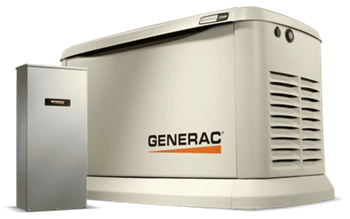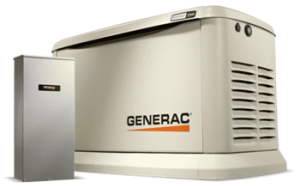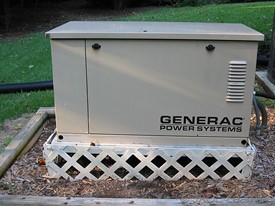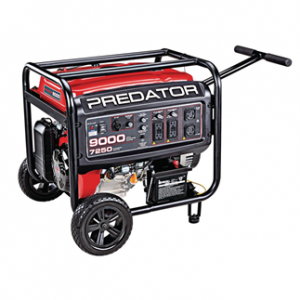Affordable Residential Generator Installation

By: Dave Varga | Jan 06, 2021
The need for a residential backup generator can vary in different areas of the country. The generator size and installation technique can also vary depending on your level of needed convenience and budget. Let’s take a look at a few different generator installation packages so you can decide what could be the best option for you and your family.
Yes, I need a residential generator!
 If you live in a Gulf Coast State or on the Southeast Coastline, you are very familiar with hurricane season and the dangers it can bring. In this hurricane–prone area your first option for a generator backup is going to be 22–kilowatt with an automatic transfer switch. This size generator is based on a typically sized home with a 200-amp service. This type of generator installation is hassle–free at storm time since it is automatically started. Extended run times are not a problem either as these units are liquid cooled and fed from a large tank of liquid propane (LP) or unlimited natural gas. For a project like this, you will need to call an electrical contractor that really specializes in this type of installation. The company will come out to survey the installation site, complete a load calculation, determine fuel connection options, and give you a detailed quote. This permitted project, installed correctly, will give you a system to last for many years and the peace of mind you and your family need at any time of year.
If you live in a Gulf Coast State or on the Southeast Coastline, you are very familiar with hurricane season and the dangers it can bring. In this hurricane–prone area your first option for a generator backup is going to be 22–kilowatt with an automatic transfer switch. This size generator is based on a typically sized home with a 200-amp service. This type of generator installation is hassle–free at storm time since it is automatically started. Extended run times are not a problem either as these units are liquid cooled and fed from a large tank of liquid propane (LP) or unlimited natural gas. For a project like this, you will need to call an electrical contractor that really specializes in this type of installation. The company will come out to survey the installation site, complete a load calculation, determine fuel connection options, and give you a detailed quote. This permitted project, installed correctly, will give you a system to last for many years and the peace of mind you and your family need at any time of year.
Estimated cost range: $17,000 – $20,000. This includes the fuel source of a typical installation.
I would like the peace of mind of a residential generator.

Hurricanes are not the only reason for power loss. Today’s aging power grid or even a summer or winter storm can put you in the dark. If you live in a more inland area or don’t have too many power losses, you might be interested in a less expensive option like a 10–kilowatt generator. A 10k with an automatic transfer switch that feeds up to sixteen essential circuits is a great option. This generator is also ready for extended run times and fueled by LP or natural gas. This installation is also hassle–free since it automatically starts and feeds the important circuits that you have selected. The home’s essential circuits could be the refrigerator, microwave, home office, heat or air conditioning, some lights and receptacles, and even the well pump and septic pump. A qualified electrical contractor would need to come out and give you a complete estimate and load calculation for the circuits you identify as essential. Today’s quality generators come with multi-year warranties and even have WIFI connections for operating status and maintenance alerts.
Estimated cost range: $14,000 – $17,000. This price also includes the rough estimate for fuel connection options.
I’m on a tighter budget, but I’m interested in a generator
 Today many people are working or learning from home and can’t afford to be without power. Just a simple option to keep some crucial items on like the refrigerator, the microwave, and a few lights and receptacles is great idea. So, if you don’t mind getting your hands dirty, here is a very affordable option. For this option you will need to purchase a portable generator, at least a 7kw or larger, with an electric start. The electric start is a great option so anyone can start it as long as the battery is kept charged. You should budget about $1,000 for this purchase and that includes a couple five-gallon gas cans and fuel stabilizer.
Today many people are working or learning from home and can’t afford to be without power. Just a simple option to keep some crucial items on like the refrigerator, the microwave, and a few lights and receptacles is great idea. So, if you don’t mind getting your hands dirty, here is a very affordable option. For this option you will need to purchase a portable generator, at least a 7kw or larger, with an electric start. The electric start is a great option so anyone can start it as long as the battery is kept charged. You should budget about $1,000 for this purchase and that includes a couple five-gallon gas cans and fuel stabilizer.
You would need to call an electrical contractor to come out and give you a quote for a 30-ampere power inlet, the associated wiring, power cord for the generator, and the very important mechanical interlock system for your electrical panel. This installation will require an electrical permit and an electrician to explain how to use it safely and to its full potential. This installation basically gives you a total or 30 amps and you can select the circuits needed and even change them at certain times by turning breakers on and off. A good example of this is turning off the smaller lighting and receptacle breakers and turning on the 30-ampere water heater for a while or running a small air conditioning unit for a while. With a little knowledge you can really do a lot with this simple and economical installation.
Estimated cost range: $3,000 – $3,500.
Resource: Generac
We cannot talk about residential generators without mentioning Generac. Anyone in the electrical business is familiar with the name Generac, their products, and their reputation. The Generac website provides all the information you need to begin finding the right product for your residential generator installation.
Consult the 2020 National Electrical Code (NEC)
Electricians must be familiar with standard installation procedures, the NEC, the manufacturer’s instructions, and any other local or state codes.
Optional Standby Systems are to comply with Article 702. This includes all permanently installed residential generators and portable generators. Portable generators using power inlets must comply with UL Standard 231 for Listed Power Outlets/Inlets. The manual transfer equipment will require an interlock device listed for use to prevent the inadvertent interconnection of all sources of supply in any operation of the transfer. All equipment must be installed according to the manufacturer’s instructions.
Have a copy of the manufacturer’s installation information on site for inspections and consult the AHJ if conflicts between the instructions and codes arise. For some installations, the calculated load (as determined by Article 220 of the 2020 NEC) must be on site for the inspector’s review. Thorough knowledge of the NEC is needed in order to determine wire size, grounding requirements, wiring methods, and more.
Consult NFPA 37 for locations and clearances for the generator placement. Make sure there is room for the LP tank (NFPA 58) or for connection of natural gas by the mechanical contractor. Have the homeowner check with the HOA for any other rules or regulations in the neighborhood. Always make sure you have all the permits required for this type of installation.


